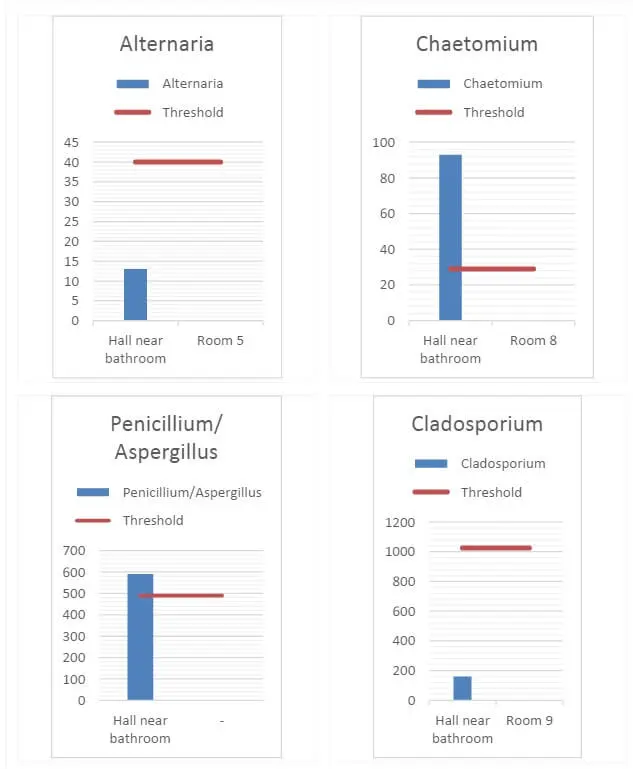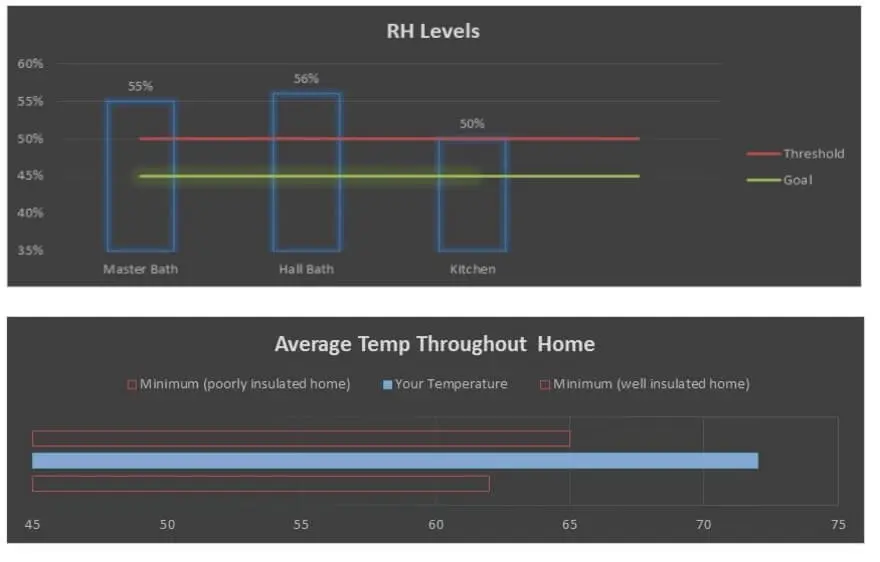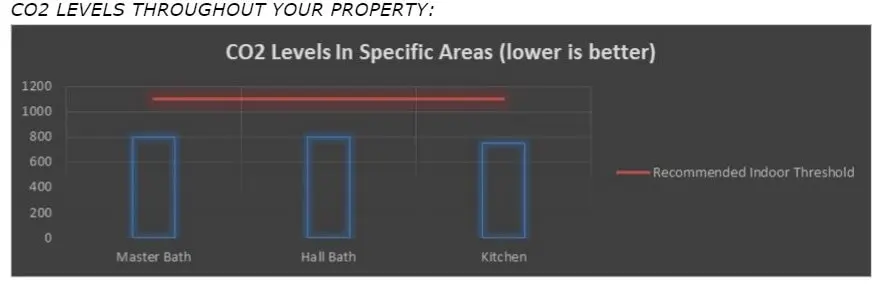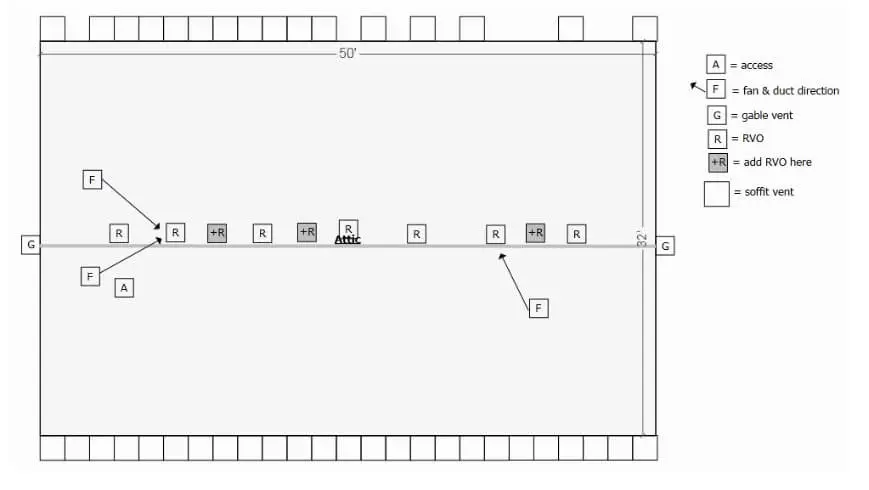Mold Remediation Reports from Bothell
Project Type > Full Home Inspection and Remediation Report for mold in Bothell
PROJECT SUMMARY
REASON FOR INSPECTION:
- Client recently moved into this home and noticed some water leakage issues causing concern for mold problems. Environix hired to inspect the home and provide recommendations where needed.
PROPERTY DESCRIPTION:
- This single family residential property was built in 1983 and is 1,286 ft².
LABORATORY RESULTS
ANALYSIS OF YOUR RESULTS:
- Minor Amplification: Mold spores were detected at or near the threshold. This indicates a possible site of mold amplification. Further testing and/or comparison with the results of a visual inspection are necessary to determine the likelihood of indoor amplification.
The most likely contributor of the elevated mold spores is:
- Elevated humidity.
- Recent water intrusion
Recommendations:
- Although your indoor mold spore count is elevated, the levels are not high enough to warrant professional remediation. By following the recommendations listed in the report and implementing regular cleaning, the mold spore levels should return to normal.
JOBSITE PHOTOS
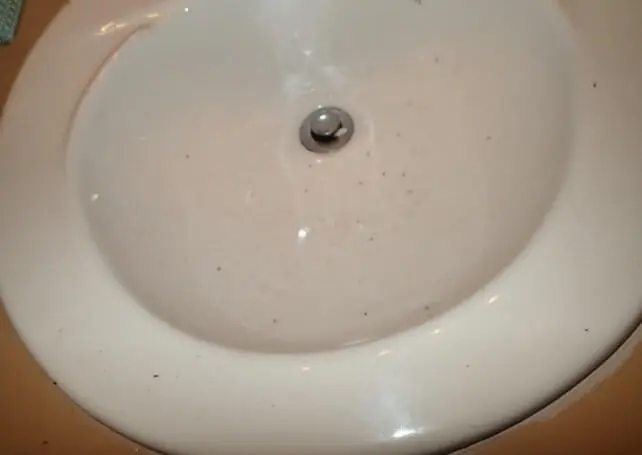
Ant infestation in bathroom sinks
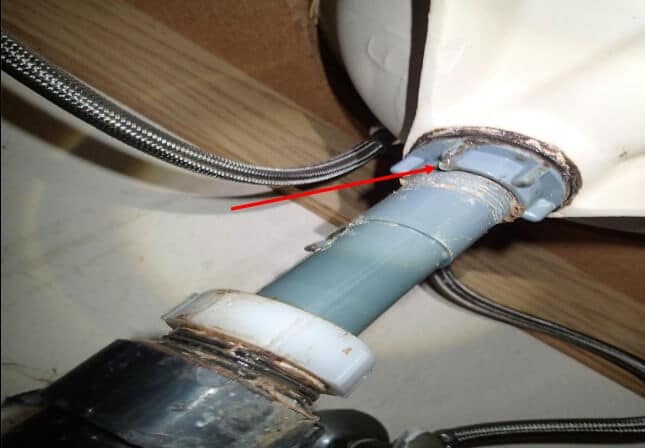
Small leak at master bathroom sink
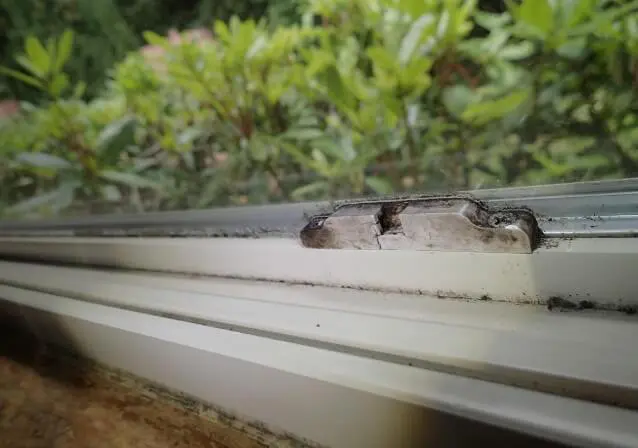
Mold growth around bedroom windows
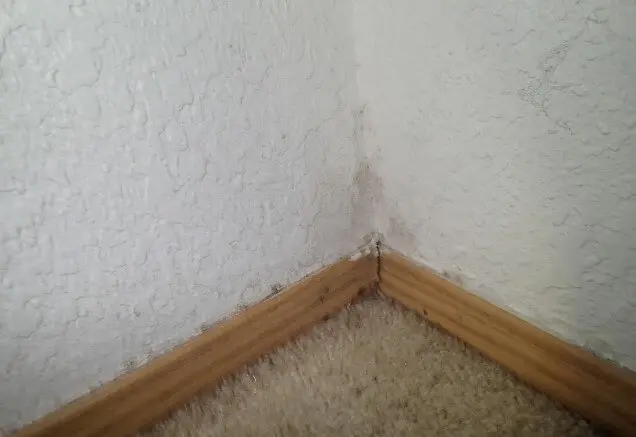
Light mold on bedroom wall from high humidity and condensation
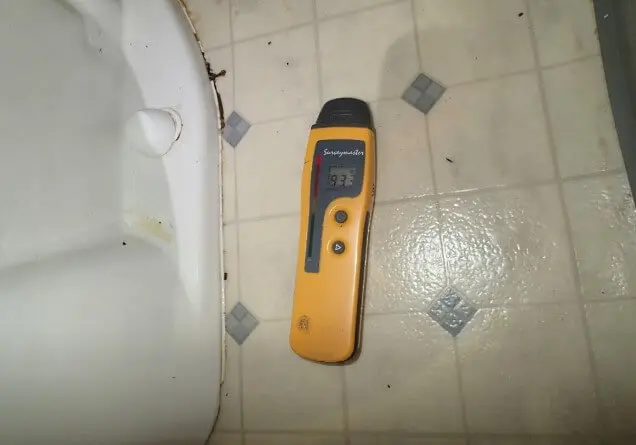
Wet subfloor around hall bath toilet indicating toilet seal leak
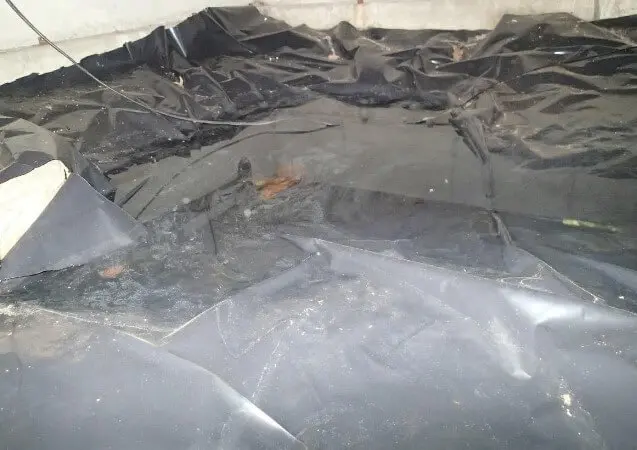
Standing water in crawlspace under bathrooms
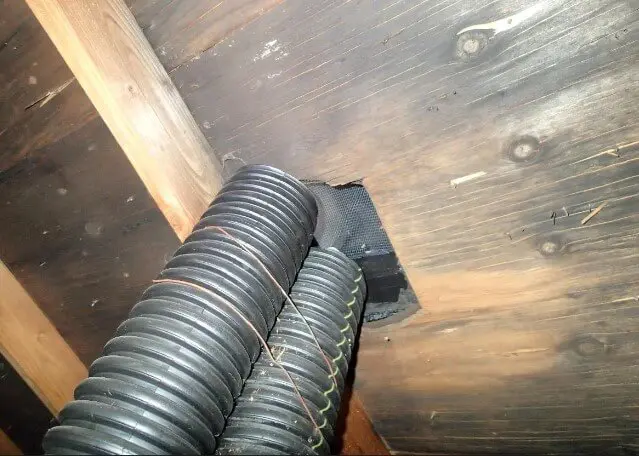
Bath fan ductings are not insulated or routed properly in attic
RELATIVE HUMIDITY & TEMPERATURE READINGS:
CO2 READINGS:
VENTILATION:
OBSERVATIONS:
- Relative humidity levels are elevated. Generally, indoor RH levels should remain under 55% or under 50% in homes with poorly insulated exterior walls.
- CO2 levels are normal. While not a direct health problem, elevated CO2 levels are an indication of stale indoor air and poor ventilation. This can lead to a buildup of pollutants and humidity, which can cause mold growth.
- VOC levels are normal. VOC levels were measured around 200 ppb throughout the home. The threshold is 500 ppb.
- Home may have been inadequately heated in winter months. A minimum indoor temp of 65ºF must be maintained in the winter months to minimize excessive humidity and mold growth.
- Home suffers from insufficient ventilation. This leads to a buildup of indoor pollutants and increases the relative humidity, creating conditions conducive to mold growth and dust mites.
LOCATION: Master Bathroom
OBSERVATIONS:
- Light mold growth noted on the wall behind the toilet, above the trim. This appears to be the result of a prior flooding incident, which has dried naturally. A slow leak was noted at the bathroom sink bowl drain. This has resulted in a puddle of standing water below this area.
- An ant infestation was noted in this bathroom. Ants appear to be crawling out of the sink bowl.
SHOWER:
- Several small areas of failed grout or caulking in shower. This can lead to water infiltration and mold growth/wood rot in the wallboard and framing behind the shower surround. However, because the potential mold growth would occur within the wall cavity, the issue has no effect on the indoor air quality.
Recommendations:
- See ventilation section above for recommendations to eliminate condensation.
- Re-grout or re-caulk the shower surround.
- Contact a plumbing contractor to investigate and repair the leaking sink.
- Contact an exterminator to investigate and eliminate the ant problem.
LOCATION: Hall Bathroom
OBSERVATIONS:
- An ant infestation was noted in this bathroom. Ants appear to be crawling out of the sink bowl.
CEILING:
- Light mold growth noted on bathroom ceiling. This occurs when the warm, moist airgenerated by shower usage interacts with the cool surface of the ceiling. Withoutadequate ventilation, this causes condensation and subsequent mold growth.
- Evidence of bubbling noted in ceiling. This is the result of ongoing exposure to elevated humidity.
SHOWER:
- Grout and caulking is in good condition and shows no signs of recent water intrusion.
FLOORING:
- Elevated moisture detected in flooring adjacent to toilet. This is due to a failure of the toilet seal. This has likely resulted in water leaking into the crawlspace below this area.
- Wood sub floor feels mushy in area in front of toilet. The sub floor may have suffered structural damage from the toilet leak. It is likely that this sub floor will require replacement when this bathroom is remodeled.
- Standing water observed on the vinyl flooring. This is the result of shower over spray and is not related to the leak problems.
Recommendations:
- When remodeling the bathroom, take appropriate steps to contain dust and potential mold spores. If significant mold growth is found, contact Environix.
- Contact a plumbing contractor to investigate and repair the toilet seal. Replace if necessary.
- Contact an exterminator to investigate and eliminate the ant problem.
LOCATION: Master Bedroom
OBSERVATIONS:
- The bedroom is equipped with double paned vinyl framed windows with prior and current evidence of heavy condensation and moderate mold problems.
- Evidence of water damage and condensation-based mold growth observed in the wood window sill. This is the result of ongoing exposure to high humidity.
- Moderate condensation-based mold was noted on exterior wall corner.
- The bedroom is furnished with carpeting in average condition.
Recommendations:
- Keep contents and furniture a minimum of 2-3 inches away from exterior walls to help prevent mold growth on these surfaces.
LOCATION: Other Bedrooms
OBSERVATIONS:
- The bedrooms are furnished with carpeting in dirty condition. Carpeting in rooms is old and a likely repository of mold spores. Carpeting can hold mold spores for long periods of time, long after the original source of the mold growth has been removed.
- The bedrooms are equipped with double paned vinyl framed windows with prior and current evidence of moderate condensation and moderate mold problems.
- Light condensation-based mold was noted on wall joints.
Recommendations:
- Remove and replace the carpeting in these rooms. Carpet removal should be performed with HEPA air scrubbers in place. Contact Environix for pricing.
LOCATION: Kitchen & Living Room
OBSERVATIONS:
- These rooms are equipped with double paned vinyl framed windows with prior evidence of moderate condensation and moderate mold problems.
- The kitchen fan has a duct, but the fan is configured in re circulation mode.
- Grease spots above the oven indicate that the prior occupants of the home did not consistently use the fan while cooking.
ATTIC OBSERVATIONS
ACCESSIBILITY & HISTORY:
- Fully Accessible. All portions of the attic were accessible at the time of the inspection.
- Some sheathing shows evidence of minor delamination. This is not a structural problem at this time. This is the result of ongoing exposure to elevated humidity.
BLACK Staining ON SHEATHING:
- Heavy mold staining covers approximately 20% of the total attic space.
- Moderate mold staining covers approximately 60% of the total attic space.
- Light mold staining covers approximately 20% of the total attic space.
- NOTE: Discoloration will remain behind even after the mold growth has died and will not fade with time. Therefore, a 2 stage treatment is typically necessary.
Trusses:
- Light mold growth noted on trusses or framing.
3 dimensional / non-staining mold growth:
- No 3 dimensional mold growth was noted in the attic space.
MOISTURE & LEAKS:
- No elevated moisture detected at the time of the inspection. However, due to the growth pattern of the mold growth, condensation based moisture likely occurs during certain times of the year. The moisture meter will often not detect the thin layer of condensation occurring on the surface of the sheathing. Additionally, condensation only occurs during cold weather. Therefore, the lack of detected elevated moisture does not eliminate condensation as the source of mold growth.
INSULATION:
Style:
- Blown-in fiberglass
Status:
- Mold Observed: Visible mold observed throughout the top layer of insulation in the attic. Mold on the insulation is not a structural concern. Typically, the mold does not grow on the actual insulation, but rather is deposited from the mold growth occurring on the attic sheathing above.
UPPER ROOF VENTILATION:
Pitch:
- Normal pitch.
Style:
- RVO style vents installed near ridge. Seven RVOs present.
RVOs are dispersed evenly. (Roof Vent Openings) - Gable vents. Two gable vents installed.
Details:
- RVOs blocked by sheathing. The sheathing is not sufficiently cut back from around the roof vents. This limits the effectiveness of the roof vents.
- Insufficient quantity of RVOs. The current quantity of RVOs is not providing sufficient air flow in the attic.
Status:
- Contributing to attic mold. Current ridge area venting is insufficient to allow for the adequate ventilation of the attic space. The lack of venting is likely contributing to the condensation and mold growth on the roof sheathing. See 3rd Party Requirements at end of this report.
SOFFIT VENTILATION:
- Proper ventilation is necessary to minimize condensation and subsequent mold growth. All areas of improper ventilation must be addressed to ensure the effectiveness of our process. Current code calls for 1sqft of ventilation for every 300 square feet of attic space, distributed evenly between the ridge and soffit area (i.e. 1sqft of soffit venting for every 600 sqft of upper floor space).
Style:
- Bird blocking. Every bay.
Status:
- Current soffit ventilation is allowing for adequate amounts of intake air into the attic space.
- Focus on indoor RH and air sealing. Lowering the indoor RH will reduce the quantity of moisture in the air infiltrating into the attic. See the suggestions in the ventilation section below. Additionally, air sealing the ceiling will significantly reduce the movement of humid air from the inside of the home to the attic space. Together, this will likely address the condensation and subsequent mold growth issues on the roof sheathing. If these steps prove insufficient, additional low venting will be required.
AIR SEALING:
Observations:
- The ceiling currently lacks proper air sealing, which can allow excess moisture and heat to escape into the attic area. This air leakage is a key cause of energy loss, attic condensation and mold growth. NOTE: Air sealing was not required by code until recently. Therefore, the lack of air sealing does not indicate a failure of the original homebuilder.
Status:
- Likely contributing. The lack of air sealing is likely contributing to the condensation and mold growth in the attic. Environix will address this in the bid, below.


